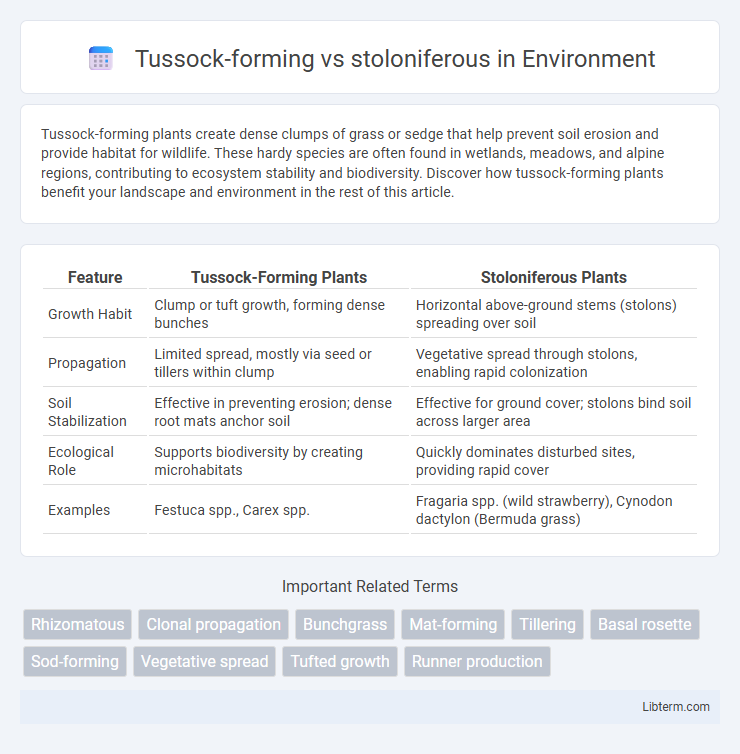Tussock-forming plants create dense clumps of grass or sedge that help prevent soil erosion and provide habitat for wildlife. These hardy species are often found in wetlands, meadows, and alpine regions, contributing to ecosystem stability and biodiversity. Discover how tussock-forming plants benefit your landscape and environment in the rest of this article.
Table of Comparison
| Feature | Tussock-Forming Plants | Stoloniferous Plants |
|---|---|---|
| Growth Habit | Clump or tuft growth, forming dense bunches | Horizontal above-ground stems (stolons) spreading over soil |
| Propagation | Limited spread, mostly via seed or tillers within clump | Vegetative spread through stolons, enabling rapid colonization |
| Soil Stabilization | Effective in preventing erosion; dense root mats anchor soil | Effective for ground cover; stolons bind soil across larger area |
| Ecological Role | Supports biodiversity by creating microhabitats | Quickly dominates disturbed sites, providing rapid cover |
| Examples | Festuca spp., Carex spp. | Fragaria spp. (wild strawberry), Cynodon dactylon (Bermuda grass) |
Introduction to Grass Growth Forms
Tussock-forming grasses grow in dense clumps or tufts, promoting soil stabilization and nutrient retention in ecosystems. Stoloniferous grasses spread through above-ground horizontal stems called stolons, enabling rapid colonization of new areas and enhancing ground cover. These distinct growth forms influence grassland biodiversity, forage quality, and erosion control strategies.
Defining Tussock-Forming Species
Tussock-forming species are characterized by dense clumps or tufts of grass that grow vertically from a central root mass, creating mounded structures that improve soil stability and water retention. These grasses, such as Festuca rubra or Deschampsia cespitosa, exhibit a growth habit vital for erosion control and habitat formation in ecosystems like wetlands and alpine meadows. In contrast, stoloniferous species spread horizontally through above-ground runners, promoting ground cover and rapid colonization but differing fundamentally in spatial growth patterns and ecological functions.
Understanding Stoloniferous Growth
Stoloniferous growth involves horizontal stems called stolons that spread across the soil surface, producing new plants at nodes, enhancing rapid ground coverage and vegetative propagation. This growth habit contrasts with tussock-forming plants, which grow in dense, clumped tufts without spreading stems, leading to localized plant density rather than expansion. Understanding stoloniferous growth is crucial for managing ground cover in lawns, gardens, and agriculture, as it influences plant competition, soil erosion control, and regeneration strategies.
Key Morphological Differences
Tussock-forming plants develop dense, clumped tufts of growth that arise from short, thickened bases, resulting in a compact, mound-like structure. In contrast, stoloniferous plants spread horizontally through creeping, above-ground stems called stolons that root at nodes to establish new shoots, promoting extensive ground coverage. Key morphological differences include the growth habit, with tussock-formers exhibiting tufted, vertical shoots and stoloniferous types having elongated, trailing stems that enable rapid colonization.
Ecological Roles and Benefits
Tussock-forming plants create dense, tufted clusters that enhance soil stability and prevent erosion by anchoring the soil with their extensive root systems. Stoloniferous plants spread horizontally through above-ground runners, promoting rapid ground cover and habitat connectivity, which supports biodiversity and reduces weed invasion. Both growth forms contribute to ecosystem resilience, with tussock-forming species improving water retention and stoloniferous species facilitating nutrient cycling across disturbed landscapes.
Adaptations to Environmental Conditions
Tussock-forming plants develop dense clumps that conserve moisture and protect roots in arid or cold environments, enhancing survival under water stress and temperature extremes. Stoloniferous plants spread horizontally through runners, allowing rapid colonization and resource acquisition in disturbed or nutrient-poor soils. These contrasting growth habits reflect specialized adaptations, with tussocks favoring stability and resource conservation, while stoloniferous species optimize spatial expansion and resilience.
Impacts on Soil and Erosion Control
Tussock-forming plants create dense clumps of roots that enhance soil structure by improving aeration and water infiltration, significantly reducing surface runoff and erosion. Stoloniferous plants spread horizontally through above-ground runners, rapidly covering soil and forming a protective mat that stabilizes loose soil particles and minimizes erosion. Both growth forms contribute effectively to erosion control, with tussock-forming species excelling in soil reinforcement and stoloniferous species providing quick ground cover for vulnerable landscapes.
Common Examples of Each Form
Tussock-forming grasses, such as Festuca ovina (sheep fescue) and Deschampsia cespitosa (tufted hairgrass), grow in dense clumps that create mounded tufts, aiding soil stabilization and resistance to trampling. Stoloniferous grasses like Cynodon dactylon (Bermuda grass) and Poa pratensis (Kentucky bluegrass) spread horizontally via above-ground runners, allowing rapid ground coverage and effective erosion control. These growth forms influence turf management, habitat restoration, and pasture productivity due to their distinct reproductive strategies and spatial expansion.
Suitability for Landscaping and Agriculture
Tussock-forming grasses create dense clumps that help prevent soil erosion and provide strong ground cover, making them ideal for landscaping projects requiring low maintenance and soil stabilization. Stoloniferous grasses spread horizontally through above-ground runners, allowing rapid area coverage, which is beneficial for agricultural pastures needing quick recovery from grazing. Choosing tussock-forming species suits slopes and poor soil conditions, while stoloniferous types excel in flat, fertile areas demanding fast establishment and uniform turf.
Choosing Between Tussock-Forming and Stoloniferous Grasses
Choosing between tussock-forming and stoloniferous grasses depends on soil stability and ground coverage needs. Tussock-forming grasses grow in dense clumps, providing excellent erosion control and deeper root systems, making them ideal for slopes and areas prone to soil displacement. Stoloniferous grasses spread horizontally through runners, creating rapid, uniform ground coverage that is perfect for lawns, sports fields, and areas requiring quick soil anchoring.
Tussock-forming Infographic

 libterm.com
libterm.com